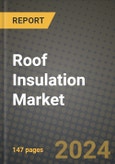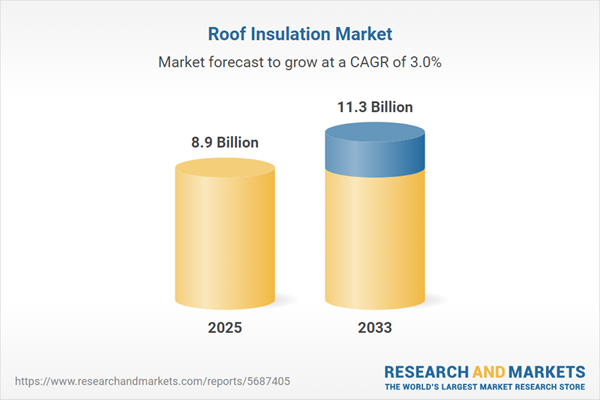The Roof Insulation market plays a vital role in modern construction, driven by increasing demand for energy-efficient buildings, sustainable materials, and stringent building codes. Roof insulation helps regulate indoor temperatures, reduce heating and cooling costs, and enhance overall thermal performance of residential, commercial, and industrial structures. With growing urbanization and awareness about climate change, governments and developers alike are placing emphasis on green building certifications and energy-saving initiatives. The market includes a variety of insulation materials such as fiberglass, mineral wool, polyurethane foam, polystyrene, and reflective insulation, each catering to different structural and climatic requirements. Advancements in material science, combined with digital construction practices, are pushing innovation in lightweight, fire-resistant, and high-R-value roof insulation solutions. As global construction activity expands and retrofitting of older buildings becomes more prominent, the demand for efficient and durable roof insulation systems continues to rise across all geographies.
In 2024, the Roof Insulation market witnessed steady growth, fueled by infrastructure modernization, energy conservation policies, and a rebound in new construction post-COVID. Europe remained a frontrunner due to its strong regulatory framework supporting energy-efficient buildings, while North America saw increased retrofitting activity supported by tax incentives and green home improvement programs. Asia-Pacific countries, particularly China and India, scaled up residential and commercial construction projects, which boosted demand for cost-effective insulation materials. Manufacturers focused on producing eco-friendly and recyclable insulation boards, incorporating recycled content and bio-based foams. Fire safety standards drove the use of mineral wool and non-combustible alternatives, especially in high-rise and commercial buildings. Supply chains improved post-pandemic, and insulation contractors adopted prefabricated systems to reduce installation time and labor costs. These developments marked a year of innovation and efficiency in the roof insulation industry, as sustainability and cost management took center stage in construction practices.
Looking ahead to 2025 and beyond, the Roof Insulation market is expected to evolve with smart technologies, integrated building systems, and stronger regulatory enforcement. Smart insulation systems capable of adjusting thermal resistance based on ambient conditions are under development, while sensor-based insulation monitoring is gaining traction in commercial buildings. Governments are likely to introduce stricter mandates around carbon neutrality and thermal efficiency, accelerating demand for high-performance materials with low environmental impact. Retrofit projects will surge as older buildings adapt to modern energy standards, especially in urban areas undergoing climate-resilient upgrades. Emerging economies will present new opportunities as urban expansion and middle-class housing drive adoption of thermal comfort solutions. Manufacturers will invest in automation and AI-driven design tools to tailor insulation systems to building geometry and climate zones. As decarbonization and energy efficiency become central to global construction strategies, roof insulation will remain a critical component in achieving environmental and economic building performance goals.
Key Insights: Roof Insulation Market
- Eco-friendly insulation materials, including recycled fibers and plant-based foams, are gaining traction as builders seek sustainable, non-toxic, and recyclable alternatives.
- Modular and prefabricated insulation panels are streamlining installation processes, reducing labor time and ensuring consistent thermal performance on construction sites.
- Digital tools and BIM integration are enhancing precision in insulation design, supporting customized solutions tailored to energy performance targets and structural layouts.
- Smart insulation technologies with embedded sensors are being explored for real-time temperature regulation and condition monitoring in commercial roofing systems.
- High-performance fire-resistant insulation materials are in demand, particularly for high-rise and public buildings, to comply with stricter fire safety regulations.
- Stringent energy codes and green building certifications are encouraging the use of advanced insulation systems in both new construction and retrofitting projects.
- Rising energy costs and awareness about carbon footprints are prompting homeowners and developers to invest in efficient roof insulation solutions.
- Global urbanization and expansion of residential and commercial infrastructure are fueling steady demand for thermal and acoustic insulation materials.
- Government incentives, tax credits, and subsidies for energy-efficient home improvements are accelerating market growth, especially in North America and Europe.
- High initial costs of premium insulation materials and lack of awareness in emerging markets remain barriers to widespread adoption, particularly in cost-sensitive residential segments.
Roof Insulation Market Segmentation
By Type:
- Batts And Rolls
- Rigid Insulation
- Reflective system
By Building Type:
- Residential
- Non-Residential
By Material:
- Glass Wool
- Stone Wool
- Plastic Foam
- Other Materials
By Application:
- Flat Roof
- Pitched Roof
By Geography:
- North America (USA, Canada, Mexico)
- Europe (Germany, UK, France, Spain, Italy, Rest of Europe)
- Asia-Pacific (China, India, Japan, Australia, Vietnam, Rest of APAC)
- The Middle East and Africa (Middle East, Africa)
- South and Central America (Brazil, Argentina, Rest of SCA)
Roof Insulation Market Size Data, Trends, Growth Opportunities, and Restraining Factors:
- This comprehensive Roof Insulation market report delivers updated market size estimates from 2024 to 2034, offering in-depth analysis of the latest Roof Insulation market trends, short-term and long-term growth drivers, competitive landscape, and new business opportunities. The report presents growth forecasts across key Roof Insulation types, applications, and major segments, alongside detailed insights into the current Roof Insulation market scenario to support companies in formulating effective market strategies.
- The Roof Insulation market outlook thoroughly examines the impact of ongoing supply chain disruptions and geopolitical issues worldwide. Factors such as trade tariffs, regulatory restrictions, production losses, and the emergence of alternatives or substitutes are carefully considered in the Roof Insulation market size projections. Additionally, the analysis highlights the effects of inflation and correlates past economic downturns with current Roof Insulation market trends, providing actionable intelligence for stakeholders to navigate the evolving Roof Insulation business environment with precision.
Roof Insulation Market Competition, Intelligence, Key Players, and Winning Strategies to 2034:
- The 2025 Roof Insulation Market Research Report identifies winning strategies for companies to register increased sales and improve market share.
- Opinions from senior executives from leading companies in the Roof Insulation market are imbibed thoroughly and the Roof Insulation industry expert predictions on the economic downturn, technological advancements in the Roof Insulation market, and customized strategies specific to a product and geography are mentioned.
- The Roof Insulation market report is a source of comprehensive data and analysis of the industry, helping businesses to make informed decisions and stay ahead of the competition. The Roof Insulation market study assists investors in analyzing On Roof Insulation business prospects by region, key countries, and top companies' information to channel their investments.
- The report provides insights into consumer behavior and preferences, including their buying patterns, brand loyalty, and factors influencing their purchasing decisions. It also includes an analysis of the regulatory environment and its impact on the Roof Insulation industry. Shifting consumer demand despite declining GDP and burgeoning interest rates to control surging inflation is well detailed.
What's Included in the Report?
- Global Roof Insulation market size and growth projections, 2024-2034
- North America Roof Insulation market size and growth forecasts, 2024-2034 (United States, Canada, Mexico)
- Europe market size and growth forecasts, 2024-2034 (Germany, France, United Kingdom, Italy, Spain)
- Asia-Pacific Roof Insulation market size and growth forecasts, 2024-2034 (China, India, Japan, South Korea, Australia)
- Middle East Africa Roof Insulation market size and growth estimate, 2024-2034 (Middle East, Africa)
- South and Central America Roof Insulation market size and growth outlook, 2024-2034 (Brazil, Argentina, Chile)
- Roof Insulation market size, share and CAGR of key products, applications, and other verticals, 2024-2034
- Short- and long-term Roof Insulation market trends, drivers, challenges, and opportunities
- Roof Insulation market insights, Porter’s Five Forces analysis
- Profiles of 5 leading companies in the industry - overview, key strategies, financials, product portfolio and SWOT analysis
- Latest market news and developments
Key Questions Answered in This Report:
- What is the current Roof Insulation market size at global, regional, and country levels?
- What is the market penetration of different types, Applications, processes/technologies, and distribution/sales channels of the Roof Insulation market?
- What will be the impact of economic slowdown/recission on Roof Insulation demand/sales?
- How has the global Roof Insulation market evolved in past years and what will be the future trajectory?
- What is the impact of growing inflation, Russia-Ukraine war on the Roof Insulation market forecast?
- What are the Supply chain challenges for Roof Insulation?
- What are the potential regional Roof Insulation markets to invest in?
- What is the product evolution and high-performing products to focus in the Roof Insulation market?
- What are the key driving factors and opportunities in the industry?
- Who are the key players in Roof Insulation market and what is the degree of competition/Roof Insulation market share?
- What is the market structure /Roof Insulation Market competitive Intelligence?
Available Customizations:
The standard syndicate report is designed to serve the common interests of Roof Insulation Market players across the value chain, and include selective data and analysis from entire research findings as per the scope and price of the publication.However, to precisely match the specific research requirements of individual clients, several customization options are offered to include the data and analysis of interest in the final deliverable.
Some of the customization requests are as mentioned below:
- Segmentation of choice - Clients can seek customization to modify/add a market division for types/applications/end-uses/processes of their choice.
- Roof Insulation Pricing and Margins Across the Supply Chain, Roof Insulation Price Analysis / International Trade Data / Import-Export Analysis.
- Supply Chain Analysis, Supply-Demand Gap Analysis, PESTLE Analysis, Macro-Economic Analysis, and other Roof Insulation market analytics.
- Processing and manufacturing requirements, Patent Analysis, Technology Trends, and Product Innovations.
- Further, the client can seek customization to break down geographies as per their requirements for specific countries/country groups such as South East Asia, Central Asia, Emerging and Developing Asia, Western Europe, Eastern Europe, Benelux, Emerging and Developing Europe, Nordic countries, North Africa, Sub-Saharan Africa, Caribbean, The Middle East and North Africa (MENA), Gulf Cooperation Council (GCC) or any other.
- Capital Requirements, Income Projections, Profit Forecasts, and other parameters to prepare a detailed project report to present to Banks/Investment Agencies.
Additional support:
- All the data presented in tables and charts of the report is provided in a separate Excel document
- Print authentication allowed on purchase of online versions
- 10% free customization to include any specific data/analysis to match the requirement
- 7 days of analyst support
This product will be delivered within 1-3 business days.
Table of Contents
Table Information
| Report Attribute | Details |
|---|---|
| No. of Pages | 150 |
| Published | August 2025 |
| Forecast Period | 2025 - 2033 |
| Estimated Market Value ( USD | $ 8.9 Billion |
| Forecasted Market Value ( USD | $ 11.3 Billion |
| Compound Annual Growth Rate | 3.0% |
| Regions Covered | Global |









